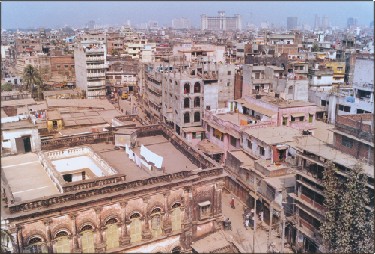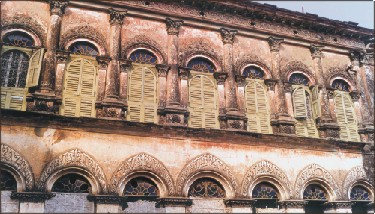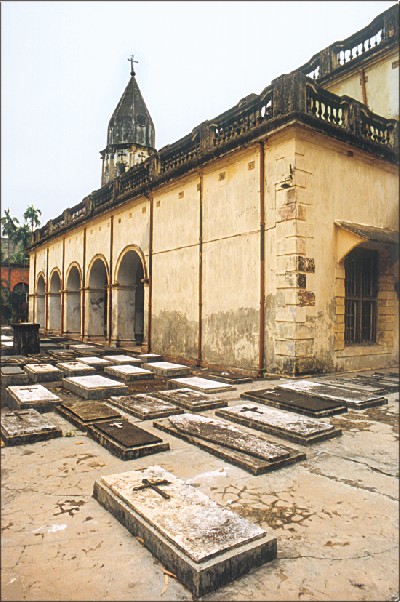
Dhaka
Monday August 18, 2003
Armanitola Silent tales of splendour IN the heart of Old Dhaka, tucked away in the narrow lanes of Armanitola, the ageing, discoloured yellow Armenian Church stands in a gloomy state of disrepair. Nearby is the Anandamoyee School which, having survived time, hardly indicates its original glory. Yet, they remain as the witness of time telling the silent tales of the splendour of Armenian Colony that once existed. It was May 20,1498 when Vasco da Gama with his four tiny ships reached Calicut to be welcomed by its Hindu ruler and marked the beginning of a fusion culture through colonialism. This expedition opened up a new vista for maritime trade between the subcontinent of India and the west followed by various European trade missions like the Portuguese, Dutch, French, Danes, Armenians, Greeks, Germans and finally the English who with their East India Company came and ruled the sub-continent for over 200 years. The Armenians settled a colony in Dhaka probably in the early 18th century. According to Bishop Heber, the Armenians who had their origin in Ispahan came to Dhaka during the time of Job Charnock, the founder of Calcutta. At Tejgaon there are some old graves of Armenians dated between 1714 to 1795 which had been built within the Roman Catholic Church of the Lady Rosary, and so indicating the probable time period of their arrival. The Armenians had one of the most dominant roles in the trades of clothes, salt and betel nut and their business in Dhaka involved spices, precious stones, carpets and indigo. Successful business made the Armenians wealthy as well as powerful. They had become such influential that to honour their request in developing a narrow water ditch of Armanitola (earlier used to dump garbage), Magistrate of Dhaka Charles Dos made a canal out of it -- 723 feet long, 18 feet wide and 16 feet deep. A bridge was also constructed for easy movement of people and traffic. May be the bridge that existed some years back between Babu Bazaar and Mitford. Rich and aristocrat Armenian families like the Pogez, Aratun, Paniati etc had built exclusive mansions in Dhaka. The Ruplal House of Farashganj was built by Aratun, the Armenian business magnet who was also the principal of the Dhaka Normal School, one of the reputable educational institution of that time.
The edifices that can testify the lost splendour of the Armenians in Dhaka are the Armenian Church and the Anandamoyee School. According to the statement of Muntasir Mamun in his book "Smrity Bismritir Nagari" there was an Armenian named Stephan still living in 1984. Residing in Narayanganj, lonely and out of touch of his own community, he used to look after the church. But after the death of his wife he stopped to step into the church premises that was loaded with happy and sad memories. History depicts that the Armenians had earlier built a small chapel on the ruined site of which was built the Armenian Church of the Holy Resurrection in 1781. It is located on Church Road, between Armanitola and the Mitford Hospital and was so named after the Armenian Colony. The ground on which the church stands used to be a cemetery before 1781. This land was the gift of Aga Catchick Minas whose wife Sophie had died in 1764 and was buried inside the church. A beautiful steeple, meant to serve as the clock tower, was erected in 1837 near the belfry where the bell was hung, but it collapsed during the severe earthquake in 1897. The sound of the big church bell was heard from distant places of Dhaka and served the citizens as an effective time directory. Although Armenia became officially Christian before the Roman empire proper and was the cradle of the domed centralised church and certain types of vaults, the Armenian Church reveals a fine example of colonial-style of architecture prevalent in the 18th century descending from early mediaeval and renaissance architectural style. The church was 700 feet long with four doorways and 27 windows. There was also a square tower within 15 feet distance of the church at the top of which was placed four turrets or minarets. The original church could be entered through a strip of 14' wide verandah and the oblong building was divided into three parts: an area enclosed by a high railing for the high altar, a central portion and another enclosed area preserved for ladies and children with a gallery over it. The altar, probably made of wood, stood in a semi-circular apse and is the termination of the church sanctuary. The
church still houses graves of Armenians leading back to the 18th century.
The epitaphs mostly of stone and depicting verses from the holy books
is said to be bought from Welseley Street of Kolkata. On one of the
epitaphs, words of a broken hearted bride-to-be touch the heart. They
were written for her 24 years old young fiancé
The present Anandamoyee School originally a mansion in Armanitola was purchased by Ananada Chandra Roy from the Armenians. Later, the building was converted by Ananda Roy into the Anandomoyee School named after his wife. The two-storey building follows the early colonial architecture with features originating from the mediaeval and European renaissance architectural style. Semicircular arches with floral motif decorations above each window opening are flanked by a series of Corinthian capital columns although the shafts are not fluted. The glass panes are covered at the exterior by green coloured louvered wooden windows. The building façade has suffered the ravages of time and looks like a multi-toned abstract painting with its worn out textured surface. Surrounded by the grim features of present Dhaka and through the claws of time, Armanitola lost its splendour or colour. The flourishing existence of the Armenians may have become a tale of today, but the name Armanitola, the Armenian Church or the Anandamoyee School still ring the bell of a time when this colony had a great influence. ........................................................
|
|
|
| (C) The Daily Star, 2003. |




